Korean Numbers: How to Count to 100+ in Korean

In this post, you'll learn all about Korean numbers, including how to count to 100+ in Korean.
Numbers are used so frequently in everyday life. And when we learn a language, we need them for all manner of things, from telling the time to paying the bill at a restaurant.
Korean is one of the most popular languages to learn right now, due in large part to its increased popularity and the worldwide fascination with Korean pop culture.
Many English speakers want to learn the language but don't know where to start. Well, why not with numbers? Everyone loves to show off how many languages in which they can count to ten. So, why not add another to your list?
Before We Get Started

Before we immerse ourselves in Korean numbers we should talk a bit about Korea. This is a very popular tourist destination celebrated for its bustling cities, advanced tech, delicious food, and fascinating culture. So, it makes sense that you want to visit Korea one day.
Korea is a land where ancient traditions meet vibrant modernity. Once you're there, you can explore the captivating beauty of this East Asian gem and communicate using your newfound knowledge of Korean numbers.
As you traverse the bustling streets of Seoul and venture into the tranquil countryside, you'll be glad of your number vocabulary for counting money, reading distance signs, and even understanding when someone tells you the time.
One highlight is Gyeongbokgung Palace, where the number of gates and halls reflects the grandeur of the Joseon Dynasty. Another great spot is the vibrant streets of Insa-dong, known for its traditional Korean crafts and artworks, each piece infused with a story of its own.
Whether you're bargaining for souvenirs in bustling markets or ordering mouthwatering dishes at local restaurants, the ability to express quantities accurately will enhance your interactions and deepen your understanding of the Korean way of life.
Two Korean Number Systems
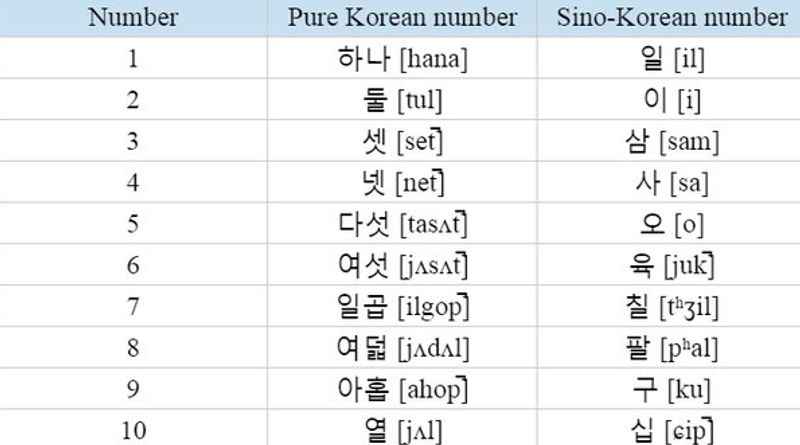
Did you know that there are two distinct Korean number systems used in the Korean language? These systems, known as Sino-Korean numbers (or the China system) and Native Korean numbers, play a crucial role in everyday conversations and interactions.
For non-native Korean speakers, understanding the differences between these two systems can be a bit perplexing. You may find yourself pondering the reasons behind having two number systems in Korean and how to navigate their usage effectively.
Fear not! We're here to shed light on this topic and provide you with the knowledge you need to confidently use Korean numbers. Let's delve into a brief overview of both systems and learn when and how to employ them.
Sino-Korean numbers, derived from Chinese characters, are typically used in formal contexts, such as telling time, expressing dates, and discussing money. On the other hand, Native Korean numbers are employed in informal situations, counting objects, and indicating age.
By grasping the intricacies of these number systems, you'll not only enhance your language skills but also gain a deeper understanding of Korean culture. So, let's delve into the fascinating world of Korean numbers and embark on an unforgettable journey through this vibrant land!
The Sino-Korean Number System
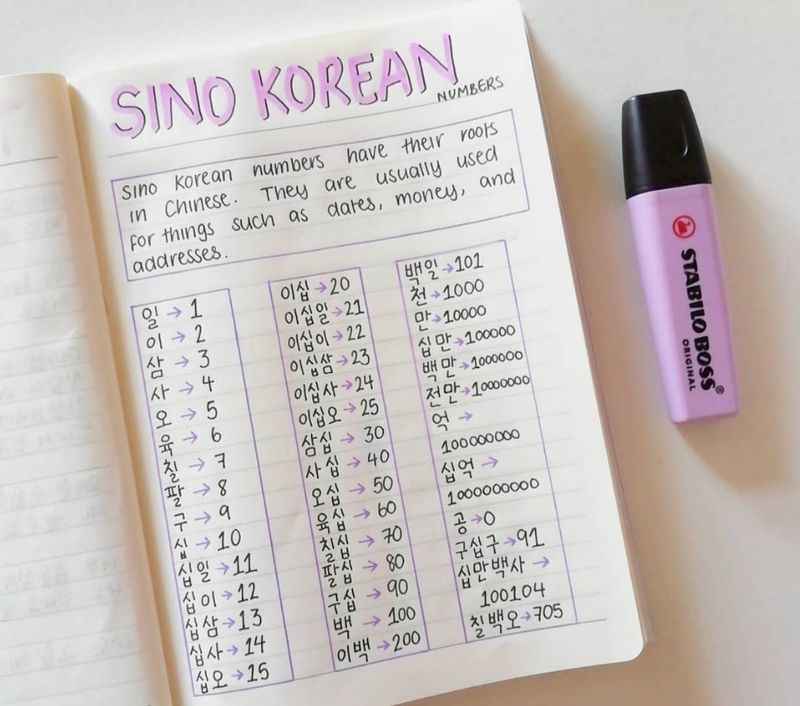 Photo Credit @ddalgi.uwu
Photo Credit @ddalgi.uwu
This first system is called Sino-Korean numbers and is derived from Chinese characters. After all, China had a big influence on the Korean writing system.
As you may know, China was very involved both politically and culturally in Korean everyday life. Before Korea developed its own system of writing, called Hangul, they used Chinese characters to write.
Sino-Korean numbers can use Chinese characters, but in modern times, they are usually written in Hangul.
Modern Koreans use the Sino-Korean numbers in Hangul but use characters that allow the numbers to be pronounced how they would have been with the Chinese numbers.
Although the Korean language has moved away from Chinese characters, there are still vestiges of the Chinese language in the Korean alphabet and especially in its numbers system.
The Sino-Korean system and Sino-Korean numbers are used to do the math, measure things, write out Korean phone numbers, count money (Korean Won), and count months, days, and years. The Sino-Korean system is also used for naming the months of the year. Pretty cool, right?
Fun Facts About Sino-Korean Numbers
- Chinese Influence: The Sino-Korean number system originated from Chinese characters and their pronunciation. Due to historical connections between China and Korea, Chinese characters were adopted and adapted into the Korean language.
- Wide Usage: The Sino-Korean numbers are extensively used in various formal settings in Korea, such as official documents, financial transactions, and academic contexts. They are also prevalent in East Asian countries like Japan and Vietnam, which have been influenced by Chinese culture.
- Time and Dates: Sino-Korean numbers are commonly used when telling time and expressing dates in Korea. For example, if it's 7:30 in the evening, you would say "7시 30분" using Sino-Korean numbers.
- Currency and Prices: When dealing with money, Sino-Korean numbers are used to express currency units, prices, and monetary values. Whether you're shopping, exchanging currency, or reading price tags, knowing the Sino-Korean numbers will be handy.
Understanding the Sino-Korean number system opens up doors to various aspects of Korean culture and facilitates effective communication in formal situations. So, embrace the beauty of this number system as you explore the rich heritage of Korea.
Native Korean Number System
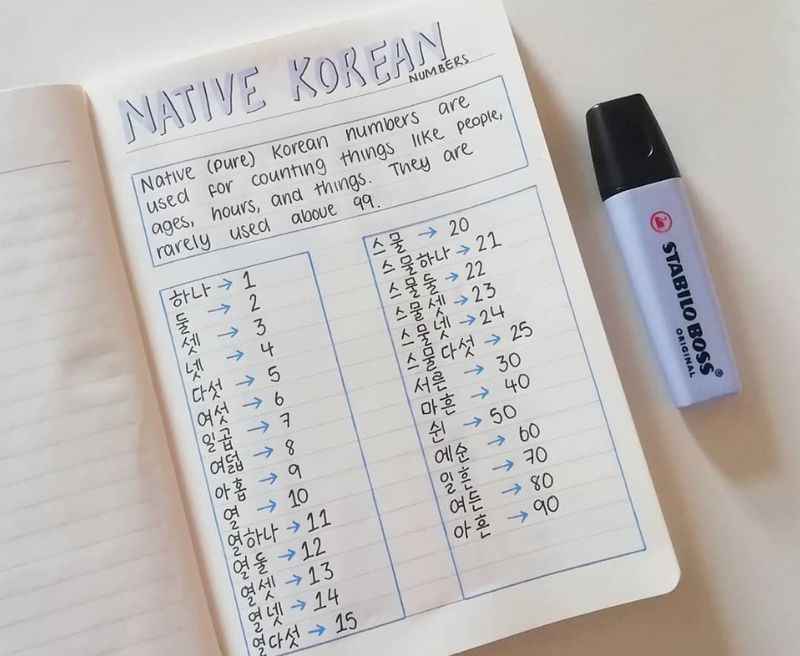 Photo Credit @ddalgi.uwu
Photo Credit @ddalgi.uwu
The native Korean system uses numbers in the native Korean writing system known as Hangul.
This number system was developed after the Sino-Korean numbers system but is just as commonly used in the Korean language today.
One major difference between the Sino-Korean numbers and native Korean numbers is that the number zero does not exist in native Korean numbers.
Despite this, there are still two different ways to say zero in the Korean language, 영 (Yeong) and 공 (Gong).
The native Korean counting system and native Korean numbers are used not only when counting things like most inanimate objects, but also when counting people, telling the time, and telling someone's age.
There are also only 99 numbers in Korean in this system.
Learning to Count in Korean
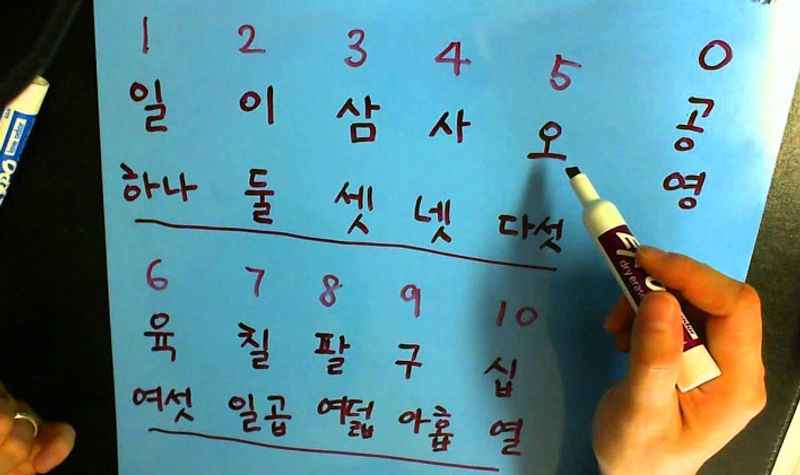
To count in Korean, you have to learn both how to write the Korean words that symbolize the Korean numbers and how to pronounce each of the Korean numbers.
It may seem like a daunting task at first, but mastering the art of counting in Korean can greatly enhance your experience when traveling to Korea. Take a look at the various uses for Korean numbers:
- Ordering Food: When dining at a restaurant or exploring street food stalls, knowing how to count in Korean will allow you to easily communicate the number of dishes or items you want to order. From trying out mouthwatering Korean barbecue to indulging in delicious street snacks, being able to count will make your culinary adventures much smoother.
- Shopping and Bargaining: Korea is renowned for its vibrant shopping scene, from trendy fashion boutiques to bustling markets. Understanding Korean numbers will come in handy when negotiating prices, calculating totals, or asking for specific quantities of items you wish to purchase.
- Public Transportation: Navigating Korea's efficient public transportation system is made easier when you can understand the numerical information displayed on bus, subway, and train signs. Counting in Korean will enable you to identify platforms, stops, and ticket fares effortlessly.
- Making Friends: Learning to count in Korean shows your interest in the local culture and language, and it can serve as a conversation starter. Locals will appreciate your efforts, and it may lead to meaningful interactions and new friendships during your travels.
How to Count in Korean: Your Ultimate Guide
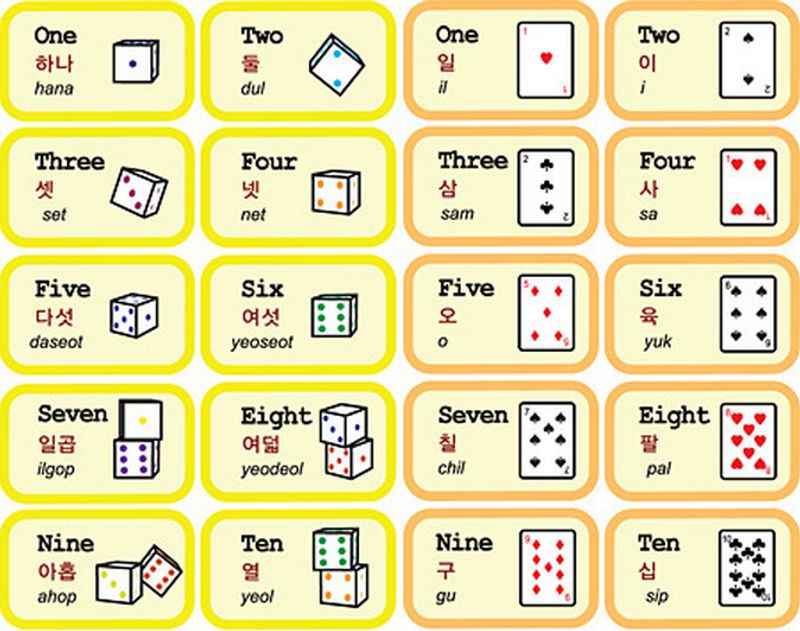
By familiarizing yourself with the Korean number system, you'll not only enhance your ability to communicate effectively but also gain a deeper appreciation for the rich culture and vibrant society that Korea has to offer. So, practice those numbers, and embark on your Korean adventure with confidence!
Below, you will find the numbers (1,2,3, etc.), followed by either the Sino-Korean numbers or the native Korean numbers.
Then, you will find the pronunciation of each number, so that you can practice pronouncing these numbers in Korean.
Numbers 1-10: The Sino-Korean Number System
1 일 (il)
2 이 (i)
3 삼 (sam)
4 사 (sa)
5 오 (o)
6 육 (yuk)
7 칠 (chil)
8 팔 (pal)
9 구 (gu)
10 십 (sip)
Numbers 1-10: The Native Korean Number System
1 하나 (hana)
2 둘 (dul)
3 셋 (set)
4 넷 (net)
5 다섯 (daseot)
6 여섯 (yeoseot)
7 일곱 (ilgop)
8 여덟 (yeodeol)
9 아홉 (ahop)
10 열 (yeol)
Korean Numbers 10-19
Now that we have the basic numbers in Korean, we will move on to the teens.
The process of counting in Korean is to combine two or more number characters together to make a new number. This process of character combination is called stacking.
With the teen numbers, all you have to do is take the character for 10, (Sino-Korean system: 십 or native Korean system: 열), and add any number from 1-9 to the right of it to make the numbers in Korean.
The Number 11 in Korean
With the Sino-Korean numbers, 10 is 십 (sip) and 1 is 일 (il), so when we combine the two it will look like this: 십일 (sipil).
We can apply the same rule to the native Korean numbers by combining 10 or 열 (yeol) and 1 or 하나 (hana) to make 열하나 (yeolhana).
Following this rule, the rest of the teens look as follows:
Sino-Korean Numbers and Native Korean Numbers
12 십이 12 열둘
13 십삼 13 열셋
14 십사 14 열넷
15 십오 15 열다섯
16 십육 16 열여섯
17 십칠 17 열일곱
18 십팔 18 열여덟
19 십구 19 열아홉
For each number, the ten is in bold so that you can see the distinction between the two in each Korean word.
Korean Number Pronunciation
All of the Sino-Korean teen numbers will start with sip, so they will go sipi (12), sipsam (13), sipsa (14), sipo (15), sipyuk (16), sipchil (17), sippal (18), sipgu (19).
All of the native Korean teen numbers will start with yeol, so they will go yeoldul (12), yeolset (13), yeolnet (14), yeoldaseot (15), yeolyeoseot (16), yeolilgob (17), yeolyeodeol (18), yeolahop (19).
For the following groupings, you will find the pronunciations next to each character so that you can see them side by side with the characters.
Numbers 20-29
Just like with the teens, the only character that changes in the group of 20s is the last one in the combination.
The number 20 in the Sino-Korean numbers is written like this: 이십 and the pronunciation is isip.
As you can see, a new character was added to the front of the ten or sip character. This new character and the sip character will remain buddies for the whole 20's grouping and will serve as the constant.
The same goes for the native Korean numbers.
The native Korean word for 10 has stayed the same and __a new character has been added to the front. The native Korean number 20 is 스물 and the pronunciation is seumul.
Sino-Korean Numbers and Native Korean numbers
21 이십일 (isipil) 21 스물하나 (seumulhana)
22 이십이 (isipi) 22 스물둘 (seumuldul)
23 이십삼 (isipsam) 23 스물셋 (seumulset)
24 이십사 (isipsa) 24 스물넷 (seumulnet)
25 이십오 (isipo) 25 스물다섯 (seumuldaseot)
26 이십육 (isipyuk) 26 스물여섯 (seumulyeoseot)
27 이십칠 (isipchil) 27 스물일곱 (seumulilgop)
28 이십팔 (isippal) 28 스물여덟 (seumulyeodeol)
29 이십구 (isipgu) 29 스물아홉 (seumulahop)
Numbers 30-39
You will now be able to spot the patterns for yourself as you work through the numbers in Korean.
Sino-Korean numbers and Native Korean Numbers
30 삼십 (samsip) 30 서른 (seoreun)
31 삼십일 (samsipil) 31 서른하나 (seoreunhana)
32 삼십이 (samsipi) 32 서른둘 (seoreundul)
33 삼십삼 (samsipsam) 33 서른셋 (seoreunset)
34 삼십사 (samsipsa) 34 서른넷 (seoreunnet)
35 삼십오 (samsipo) 35 서른다섯 (seoreundaseot)
36 삼십육 (samsipyuk) 36 서른여섯 (seoreunyeoseot)
37 삼십칠 (samsipchil) 37 서른일곱 (seoreunilgop)
38 삼십팔 (samsippal) 38 서른여덟 (seureunyeodeol)
39 삼십구 (samsipgu) 39 서른아홉 (seureunahop)
Numbers 40-49
As we head into the 40s, you can see that numbers in both Korean number systems are actually very straightforward.
Sino-Korean Numbers and Native Korean Numbers
40 사십 (sasip) 40 마흔 (maheun)
41 사십일 (sasipil) 41 마흔하나 (maheunhana)
42 사십이 (sasipi) 42 마흔둘 (maheundul)
43 사십삼 (sasipsam) 43 마흔셋 (maheunset)
44 사십사 (sasipsa) 44 마흔넷 (maheunnet)
45 사십오 (sasipo) 45 마흔다섯 (maheundaseot)
46 사십육 (sasipyuk) 46 마흔여섯 (maheunyeoseot)
47 사십칠 (sasipchil) 47 마흔일곱 (maheunilgop)
48 사십팔 (sasippal) 48 마흔여덟 (maheunyeodeol)
49 사십구 (sasipgu) 49 마흔아홉 (maheunahop)
Numbers 50-59
Much like with the previous groups of numbers, we have the root ("fifty") and the digit at the end in both number systems. For the fifties, it is osip in Sino-Korean and swin in Native Korean.
Sino-Korean Numbers and Native Korean Numbers
50 오십 (osip) 50 쉰 (swin)
51 오십일 (osipil) 51 쉰하나 (swinhana)
52 오십이 (osipi) 52 쉰둘 (swindul)
53 오십삼 (osipsam) 53 쉰셋 (swinset)
54 오십사 (osipsa) 54 쉰넷 (swinnet)
55 오십오 (osipo) 55 쉰다섯 (swindaseot)
56 오십육 (osipyuk) 56 쉰여섯 (swinyeoseot)
57 오십칠 (osipchil) 57 쉰일곱 (swinilgop)
58 오십팔 (osippal) 58 쉰여덟 (swinyeodeol)
59 오십구 (osipgu) 59 쉰아홉 (swinahop)
Numbers 60-69
This time we are looking out for yuksip (Sino-Korean) and yesun (Native Korean).
Sino-Korean Numbers and Native Korean Numbers
60 육십 (yuksip) 60 예순 (yesun)
61 육십일 (yuksipil) 61 예순하나 (yesunhana)
62 육십이 (yuksipi) 62 예순둘 (yesundul)
63 육십삼 (yuksipsam) 63 예순셋 (yesunset)
64 육십사 (yuksipsa) 64 예순넷 (yesunnet)
65 육십오 (yuksipo) 65 예순다섯 (yesundaseot)
66 육십육 (yuksipyuk) 66 예순여섯 (yesunyeoseot)
67 육십칠 (yuksipchil) 67 예순일곱 (yesunilgop)
68 육십팔 (yuksippal) 68 예순여덟 (yesunyeodeol)
69 육십구 (yuksipgu) 69 예순아홉 (yesunahop)
Numbers 70-79
Hopefully, these two number systems are now becoming very predictable and familiar to you.
Sino-Korean Numbers and Native Korean numbers
70 칠십 (chilsip) 70 일흔 (ilheun)
71 칠십일 (chilsipil) 71 일흔하나 (ilheunhana)
72 칠십이 (chilsipi) 72 일흔둘 (ilheundul)
73 칠십삼 (chilsipsam) 73 일흔셋 (ilheunset)
74 칠십사 (chilsipsa) 74 일흔넷 (ilheunnet)
75 칠십오 (chilsipo) 75 일흔다섯 (ilheundaseot)
76 칠십육 (chilsipyuk) 76 일흔여섯 (ilheunyeoseot)
77 칠십칠 (chilsipchil) 77 일흔일곱 (ilheunilgop)
78 칠십팔 (chilsippal) 78 일흔여덟 (ilheunyeodeol)
79 칠십구 (chilsipgu) 79 일흔아홉 (ilheunahop)
Numbers 80-89
Continuing into the 80s, we have palsip and yeodeun.
Sino-Korean Numbers and Native Korean Numbers
80 팔십 (palsip) 80 여든 (yeodeun)
81 팔십일 (palsipil) 81 여든하나 (yeodeunhana)
82 팔십이 (palsipi) 82 여든둘 (yeodeundul)
83 팔십삼 (palsipsam) 83 여든셋 (yeodeunset)
84 팔십사 (palsipsa) 84 여든넷 (yeodeunnet)
85 팔십오 (palsipo) 85 여든다섯 (yeodeundaseot)
86 팔십육 (palsipyuk) 86 여든여섯 (yeodeunyeoseot)
87 팔십칠 (palsipchil) 87 여든일곱 (yeodeunilgop)
88 팔십팔 (palsippal) 88 여든여덟 (yeodeunyeodeol)
89 팔십구 (palsipgu) 89 여든아홉 (yeodeunahop)
Numbers 90-99
Finally, we have the 90s in both number systems.
Sino-Korean Numbers and Native Korean Numbers
90 구십 (gusip) 90 아흔 (aheun)919293949596979899
91 구십일 (gusipil) 91 아흔하나 (aheunhana)
92 구십이 (gusipi) 92 아흔둘 (aheundul)
93 구십삼 (gusipsam) 93 아흔셋 (aheunset)
94 구십사 (gusipsa) 94 아흔넷 (aheunnet)
95 구십오 (gusipo) 95 아흔다섯 (aheundaseot)
96 구십육 (gusipyuk) 96 아흔여섯 (aheunyeoseot)
97 구십칠 (gusipchil) 97 아흔일곱 (aheunilgop)
98 구십팔 (gusippal) 98 아흔여덟 (aheunyeodeol)
99 구십구 (gusipgu) 99 아흔아홉 (aheunahop)
Numbers 100 and Above
After 99, you don't have to worry about the native Korean numbers anymore.
Since you now know how to count in Korean in the double digits, you can use the same tools to count in the triple digits and beyond.
Just like above, the bigger the number, the more to combine. As you stacked the characters for the 10s through the 90s, you'll now stack even more characters to create bigger numbers.
Hundreds and Thousands in Korean Numbers
The Sino-Korean number for 100 is 백 or baek.
For each number in the 100's, you will add the smaller number in front of the 백. There are a few examples of the triple digits below:
300 셋백 (sambaek)
400 사백 (sabaek)
500 오백 (obaek)
1,000 in Korean: 천 (cheon)
The Korean number for one thousand is 천 or cheon.
The same rules that apply to the 100s apply to the thousands as well. For example:
2000 이천 (icheon)
3300 삼천 삼백 (samcheon sambaek)
10,000 in Korean: 만 (man).
The Korean number for ten thousand is 만 or man.
This is an important word because, after this number, thousands of numbers in Korean that are bigger than this use the 만 symbol.
Such numbers include:
- 100,000 (십만 or simman)
- 1,000,000 (백만or baekman)
- 10,000,000 (천만 or cheonman).
Phone Numbers in Korean
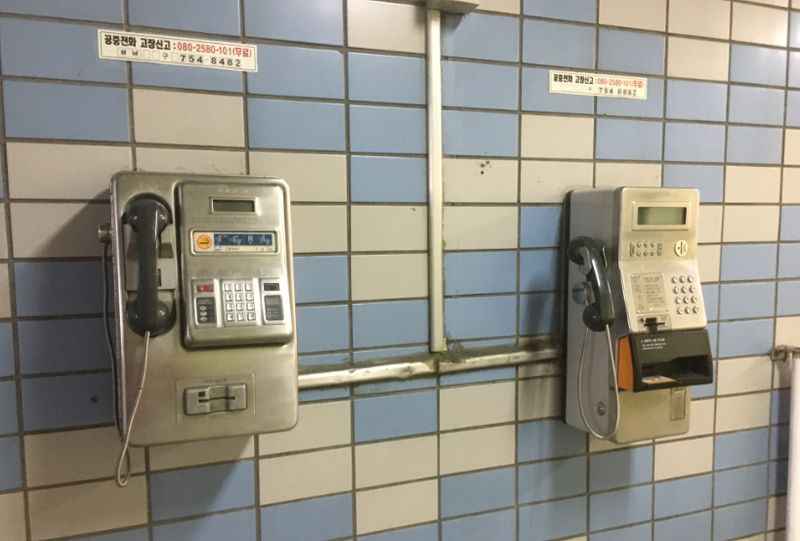
Phone numbers are different in every country and it gets even more complicated when different languages use different characters. So, before you head to Korea, let's take a look at Korean phone numbers.
In English, we are used to using the Arabic numeral system to count. However, in Korean, telephone numbers are written out in Sino-Korean numbers.
This means they can look like very long compound words, which is a little intimidating. Follow the rules above for bigger numbers to write out phone numbers in Korean.
Master the Art of Counting and Embrace a New Culture

Mastering the Korean native numbers and the Sino-Korean system opens doors to effective communication as you share your age with new acquaintances, tell someone the time, count money, and so on. These systems will help you to live, work, and travel in Korea.
Whether conversing with warm-hearted locals or decoding ancient architecture, incorporating these important words into your language learning will undoubtedly open doors and hearts.
So pack your bags and get ready to embark on an eye-opening adventure where you'll explore the wonders of Korea through the lens of its beautiful language and cultural heritage.
Ways to Learn Korean Numbers

Many people wonder how much time it takes to learn Korean numbers. The answer varies depending on your commitment and the learning method you choose. With consistent practice and study, you can become proficient in counting within a few weeks or months.
To expedite your learning process, consider online tutoring. Online platforms like Fiverr offer a convenient way to connect with native Korean tutors who can guide you through the intricacies of Korean numbers.
These experienced tutors (find a native Korean speaker) provide personalized lessons tailored to your learning style and pace, making your language journey more engaging and effective.
Fiverr's pool of native tutors ensures you'll receive authentic and accurate instruction. Their expertise not only helps you grasp the fundamentals of Korean numbers but also deepens your understanding of Korean culture, etiquette, and customs—essential knowledge for a fulfilling travel experience.
As you prepare for your Korean adventure, remember that language learning is an ongoing process. Dont feel frustrated if you don't learn two Korean number systems in a week. It takes time. Embrace the challenge, stay motivated, and practice regularly.
With dedication and the right support, you'll soon find yourself confidently counting in Korean and immersing yourself in the vibrant culture of Korea. Get ready to embark on an unforgettable journey filled with incredible sights, mouthwatering cuisine, and warm hospitality.
Where to Travel in South Korea
So, with all of that being said, are you ready to head to Korea on your own adventure? If you aren't sure where to go first, check out the helpful guide below that details some of the best places in Korea.
Seoul

As the vibrant capital city of South Korea, Seoul offers a captivating blend of tradition and modernity.
In Seoul, you can explore historic palaces like Gyeongbokgung, indulge in delicious street food at Gwangjang Market, and immerse yourself in the energetic atmosphere of Gangnam district. Seoul's dynamic culture and impressive landmarks make it a must-visit destination.
Jeju Island

Located off the southern coast, Jeju Island is a natural paradise with stunning landscapes.
At Jeju Island, you can explore the majestic Seongsan Ilchulbong Peak, stroll along the scenic Jeongbang Waterfall, and relax on picturesque beaches like Hamdeok. Jeju's serene beauty, volcanic wonders, and unique culture make it a perfect getaway.
Busan

Situated on the southeastern coast, Busan offers a delightful mix of urban charm and coastal beauty.
Here, you can visit the bustling Jagalchi Fish Market, relax at Haeundae Beach, and explore the colorful Gamcheon Cultural Village. Busan's vibrant atmosphere, delicious seafood, and breathtaking ocean views make it a must-see destination in Korea.
Summing Up: How to Count to 100+ in Korean
After reading this post, you should hopefully feel confident about your Korean skills and feel ready to show off how to count in Korean at your next gathering.
Korean can be harder than other languages but can be so rewarding if you work on it and start to feel good about your language learning.
If you are interested in learning Korean, check out Korean Uncovered, a Korean language course designed by polyglot Olly Richards. The link below will provide free trial access. Good luck!







